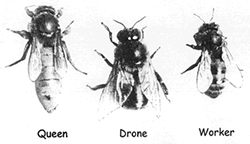SPLITTING
HIVES
Reducing hive populations is a way to "cool" the bees down this
time of the year and thus postpone their urge to swarm. Hives are split
by removing frames of bees and brood and placing them into another box
which forms a nucleus to start a new hive. Bees require a minimum population
of around 1000 in order to function as a colony and the nucleus (nuc for
short) provides this and more. In practice, it's not quite as simple as
it sounds because the bees and frames of brood must be removed from the
hive without the queen. Queens are time consuming to find and when splitting
hundreds or thousands of hives there isn't time to hunt up queens.
The queen excluder, designed to be placed between boxes, consists of a precisely spaced wire grid that the queen, because of her larger size, can't get through (see pictures). After pulling frames from the hive, all the bees are then shaken back into the hive and the frames are placed into another empty box as shown.
The queen excluder is placed on the hive and the box with the frames - less the bees - are then added to the stack. After replacing the lid, the setup is finished. In a few hours time, the bees will migrate up through the queen excluder to cluster on the frames above as shown in the last picture at right.
Worker
bees spend the first several weeks of their life span inside the hive,
never going outside, until they take their first flight and graduate to
the field force. Once this transition has been made, they will spend the
rest of their life flying whenever possible from sunup til sundown seven
days a week gathering food, water and other essentials for the colony.
During the young bees time before flight, one of their principal duties
is to attend to and feed the brood (larva). So it is these bees that migrate
through the queen excluder to resume their duties with the brood now on
the frames above.
It is the younger bees that make the most desirable split because they will most readily accept a new queen. For this and other reasons discussed, the method of splitting hives with the use of a queen excluder is preferred.






